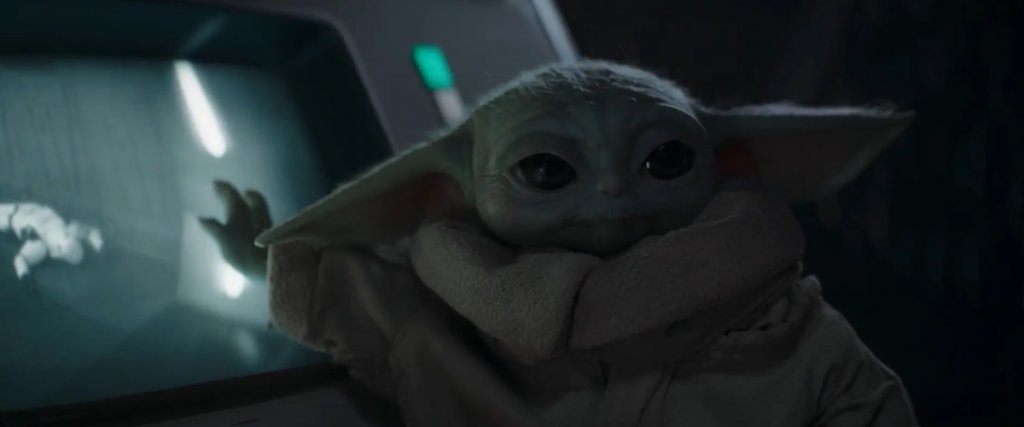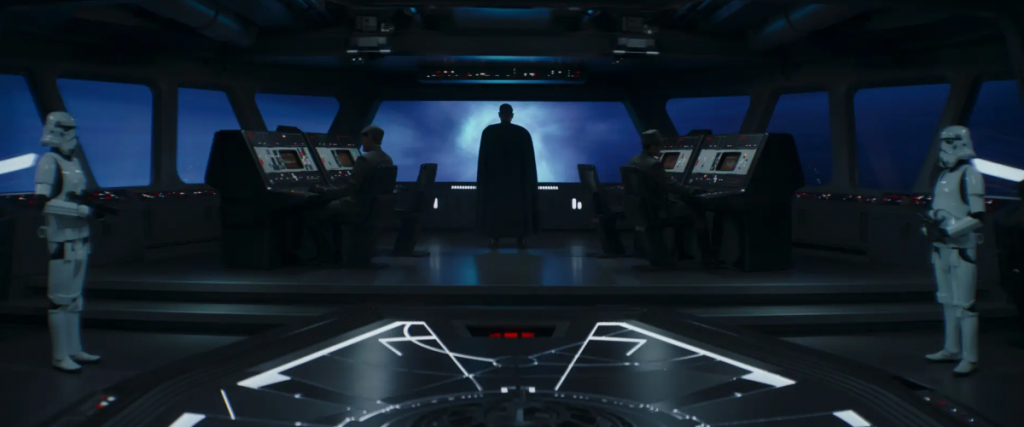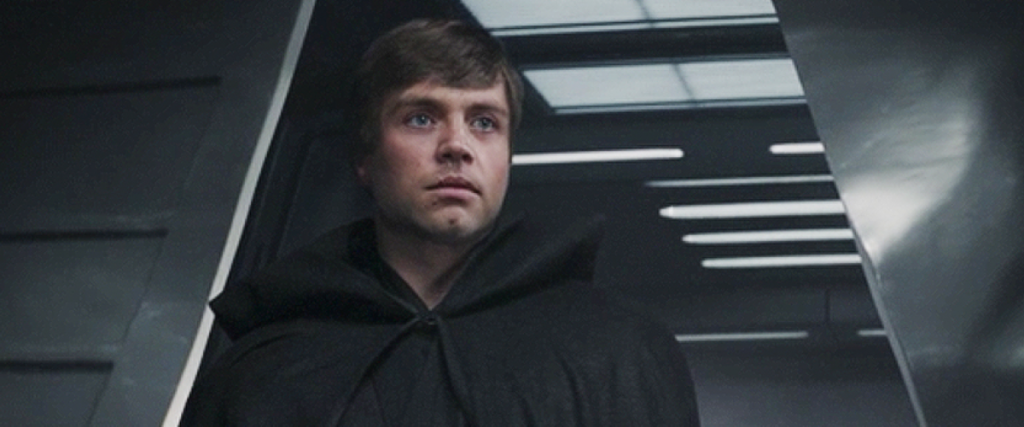The Rescue
There is an elephant in the room, and that elephant’s name is Luke Skywalker. Chapter 16 of The Mandalorian ended with a familiar face (or at least, an uncanny approximation of a familiar face), and feelings are pretty mixed on it. Some folks are over the moon about it; other folks are decidedly under the moon about it; and some folks are Michael Collins, annoyed that Lucasfilm chose the Buzz Aldrins of the fandom to land on the moon instead of them.
There are a lot of explanations for why Luke Skywalker does and doesn’t make sense. He’s familiar to the audience. He makes sense for the timeline. He’s safe. He’s too safe. He’s an unimaginative choice. It could have been someone else. All good points. But what about the actual story of the episode?

The Rescue underlines what for me is now the obvious-in-hindsight theme of the season: attachment. On a surface level, it’s about the attachment between Din and Grogu, but that theme is repeated everywhere. Boba Fett’s attachment to his armour. Bo-Katan’s attachment to the Darksaber. The Empire’s attachment to power. Din’s attachment to the Creed, and to his past. Because this is Star Wars, attachment is presented as a double-edged sword: the same attachment that drives Din Djarin to save Grogu is the same attachment that might corrupt his training. This is a story about having, belonging, and letting go.
But we all love Baby Yoda, and no one loves Grogu more than Din Djarin. Their relationship is the heart and soul of this show. It’s the catalyst that forces Din to confront his past and challenge his identity. He has become a better person for The Child, because of The Child, and none of us want that connection to be gone. From a certain point of view, it even seems like that’s the best option. Only Din can connect with Grogu. Our favourite little frog-chomper will only magically float things for him. If that’s all it is, if that’s all it takes, then surely Din Djarin is enough. He’s got this. Ahsoka’s warnings were just paranoia, not everyone is Anakin Skywalker.
Alas, it not that simple. Din Djarin has two superpowers: blissful ignorance, and getting knocked on his ass. He doesn’t know what a Jedi is, not really. The Armorer described them as enemy sorcerers, and that’s about all he has to go on. He’s met Ahsoka, and she measures up to that description. She’s certainly formidable enough to go toe to toe with a Mandalorian, so that’s the enemy descriptor covered, and she does the same floaty stuff that The Kid does, so yep, sorcerer. None of this seems to phase Din. He takes it in stride, like he does with everything else. Whether it’s Jedi, or Tusken Raiders, or Frog Ladies, Din knows he doesn’t need to understand it, just accept it. And if Jedi are just what he saw from Ahsoka, then no biggie. It’s just fetch and fight training. Din’s got this. Right?

Of course, we know that the Force is much more than that. But Din doesn’t.
Enter Luke Skywalker. After seeing Din barely manage to hold his own against a single Dark Trooper, in walks Luke Skywalker to breeze his way through an entire platoon. The fact that he’s only a hair away from Vader in Rogue One is no accident either: this is a wake-up call for Din Djarin, a showcase of Grogu’s potential if he explores his Force power’s further. It is terrific and terrifying, awe-inspiring in the most archaic sense of the term. By using Luke, and echoing Vader, the audience implicitly understands what Din must be feeling as he watches this. We’re meant to feel conflicted, because that’s exactly what Din is going through. Oh shit, look at what my son has the potential to become!
Oh shit, look at what my son has the potential to become.
The Rescue doesn’t leave the Vader parallels to chance, either. While Luke himself is busy mirroring Rogue One, Din gets his own homage to Return of the Jedi. We’ve had glimpses this season of what the view looks like through the visor of his helmet, all discoloured and synthetic. As Grogu reaches for his cheek and can’t touch it, Din decides that it’s time to look upon his son with his own eyes. Through imagery, this scene gets to double down not just on the theme of attachment and letting go, but on the core theme of fatherhood as well. Luke Skywalker brings that to the table in a way that alternatives wouldn’t have. The conflict in Luke, the fate of his father and his nephew, all that conspires to deepen the obvious peril towards Grogu’s fate. Din needed this experience, to fully understand why he needs to let Grogu go.
This was a Razor Crest moment. Din’s ship has always been a totem of his past. Visually, it echoes his armour. Narratively, it’s pre-Empire, he doesn’t have to run a beacon, he doesn’t have to choose a side. Thematically, it has been beaten and broken in parallel to Din’s image of himself and his concept of Mandalorians. When it is destroyed, the only thing left in the wreckage is that spear: simultaneously a Chekhov’s gun for his inevitable showdown with Gideon, and a literal straight arrow to become a new representation of Din. Losing the Razor Crest destroyed any hope of going backwards. It left Din with no choice. His pre-Empire neutrality is gone, and woe unto those that incurred his wrath. Luke Skywalker is the same: a no going back moment that leaves Din with no choice about what needs to happen next.

But did it have to be Luke? In my opinion, yes. Not for the audience, not for the timeline, but for the themes of the story. We know now that the story The Mandalorian set out to tell ends (for now) with Din Djarin letting go of everything. Whichever Jedi showed up, the story needed it to be someone who would take Grogu away to be trained.
People have suggested Ezra Bridger as an alternative. He’s definitely a character who has struggled under the looming spectre (pun intended) of the dark side. But that detail is not as quickly or as viscerally conveyed as Luke fighting in that corridor. There’s also the fact that Ezra’s story is all about family. He was trained alongside Rebels and Mandalorians, so why can’t Grogu be? This was certainly my preference going into the episode, but Grogu staying with Din was not the story that they set out to tell. They needed someone who would come for Grogu and take him away to be trained, and that just isn’t Ezra Bridger. He has daddy issues for sure, but they’re a different kind.
Cal Kestis is another suggestion, and another character I would absolutely love to see in live action. He (one would hope) still has a crew of his own, so he has a welcoming environment in which Grogu could thrive, not to mention (hopefully) access to a wise Jedi Master and the alternate perspective of a Nightsister. My don’t-get-your-hopes-up pick for Grogu’s mentor was actually Merrin, because I love the idea of the Jedi in Grogu’s life becoming a maternal figure, and the Mandalorian vs Force influences on him being played out as a mother vs father dynamic. That’s the story I would have wanted to see told, but that’s not the story that Favreau and Filoni created. It’s also the wrong direction for Cal and Merrin’s story. Fallen Order is a story about Cal Kestis letting go of the Jedi Order, and picking a new path forward. There’s certainly enough time since the game for his attitudes to have changed, but Cal had his opportunity to find Younglings and rebuild the Jedi, and he made a different choice. Cal of this era feels like he should be more of an Ahsoka figure: someone choosing the Jedi path for himself, but not trying to pass it onto others.
But again, enter Luke Skywalker. Cal may have let the Jedi Order go, but Luke? One of the themes of this arc was attachment, and Luke’s big dangerous downfall attachment is the Jedi Order, or at least, the idea of the Jedi. The Luke that we see in The Last Jedi has lost that which he dedicated his life to loving, and it undoes him. His failure is being beholden to the past, and Rey represents the escape from that into new ideas. That impending failure plays into the story here. We know that Luke wants to rebuild the order, because we’ve seen that he did so. It makes perfect sense that he would take Grogu away, and there’s a bitter aftertaste to it because we know that if things continue along this path, it will end badly for Grogu. It makes the moment bittersweet: Din has let go of his son because he believes Grogu will be safer with Luke Skywalker, but we at home know that this might not actually be true. We desperately want Grogu to stay with his father for our own viewing pleasure, but we also desperately want Din to know that no actually, Grogu is probably safer with you.

There’s one other moment in this episode ringing in my head like an air raid siren. When Din and Gideon have their confrontation in the cell, the Moff explains what he wants with The Child. Not him, just his blood, because it will restore order. In Chapter 15’s utterly phenomenal table scene, the idea that the galaxy wants order more than freedom is conveyed to chilling effect. Here, order is delivered as a synonym for oppression, for evil.
But what does Luke Skywalker want with The Child? To restore order. To restore the Jedi Order, rather than the New Order, or the First Order. We don’t know what Luke and Grogu communicated about thanks to their Tython Skype call, but on the face of it, Luke isn’t someone who knows or cares for Grogu. We don’t see him have the patient, meaningful moments with him that Ahsoka had in Chapter 13. From the perspective of the story as framed, Luke is someone showing up because he was invited to, yes, but also because he has an agenda. He wants The Child to restore his order, exactly the same as Moff Gideon. It doubles down on the idea that the best place for Grogu is with Din, because Din is the only one motivated purely by his son’s wellbeing.
That’s important. At least, I hope it is, because I hope that the realisation of this is part of the story’s road forward. I hope that Grogu has been taken out of the equation purely so that Din has the opportunity to reevaluate himself and decide who he wants to be outside of the context of fatherhood, so that when Grogu does eventually return he has a healthier, happier, more realised life to integrate a son into. That is (I imagine) probably what the Disney marketing team is hoping for as well.
And this is why Luke Skywalker was the right choice: because he’s the wrong choice. He’s the right choice because Din Djarin needed to see the son of Vader as a wake-up call. He’s the right choice because Din learns about the Jedi from the same example that we the audience did. He’s the right choice because unlike Ezra or Cal or Mace Windu or whoever else, Grogu may not actually be better off with Luke after all. He’s the right choice because we aren’t happy about Grogu leaving with him.
Or at least, that’s how it all looks from a certain point of view.